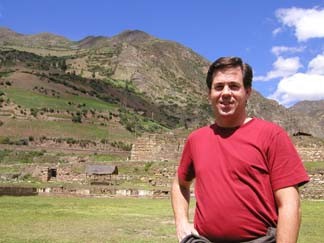Jeff Morgan's global approach to preservation could bring tourism, stability to postwar Iraq
By Linda Myers
Preservationist Jeff Morgan '84 has a vision for Iraq. The country may be war-torn, but with such ancient cities as Ur, Babylon and Nineveh within its borders, he says, postwar Iraq could launch a tourism trade to rival Peru's Inca fortress of Machu Picchu – protecting the country's archaeological treasures and providing economic stability for its people in the process.
As for the current wave of violence in Iraq, things change, said Morgan, who majored in historic preservation planning as an undergraduate in the College of Architecture, Art and Planning (AAP) and is now executive director of Global Heritage Fund (GHF), a Silicon Valley-based nonprofit conservancy. "Peru was Shining Path 10 years ago. Now Shining Path is gone and 1,500 people a day visit Machu Picchu," resulting in hundreds of millions of dollars in annual revenue for Peru. Guatemala's Tikal brings in close to $200 million a year, while Cambodia's temples of Angkor Wat generate 30 percent of the country's gross national product, he noted.
Tourism in Iraq might never outpace the country's oil-based revenues, but with Morgan's help, it stands a fighting chance. Since founding GHF in 2001, he has brought his unique blend of city planning, science-driven archaeological and ecological preservation and business savvy to ancient sites in China, Guatemala, India, Peru, Russia and Vietnam. In each case, GHF partners with local government and industry to fund a plan for protecting and preserving the site while bolstering economic development through tourism.
GHF academic adviser Michael Tomlan, director of AAP's Historic Preservation Planning Program, was integral in Morgan's efforts in Hampi, India, once the seat of the Vijayanagara empire and now home to some 5,000 employees of Jindal Steel's iron mines. Tomlan facilitated partnerships with Jindal, archaeologists from Delhi School of Architecture and Planning and government officials.
To involve community members in the process, GHF relied on bilingual and trilingual communication, creating a preservation plan that met the needs of people who live near the site. "Morgan knows that you have to respect and conform to their point of view," said Tomlan. "Unless and until you do, you're really not helping them."
In Lijiang Ancient Town in Yunnan, China, where encroaching development threatened to wipe out architectural elements from early in the city's 1,000-year history, GHF developed a matching grant program to help low-income residents restore their homes. In Guatemala's Mirador Basin, a 600,000-acre virgin rain forest once at the center of Mayan civilization, looters were stealing close to $10 million in jade statues, artifacts and pottery each month. GHF provided support and training for park rangers and guards, reducing looting by more than 90 percent.
Hoping for similar successes in Iraq, the conservancy hosted a 10-day conference in June 2004 for 30 specialists from Iraq, Jordan, the World Bank and the United Nations. The following month GHF signed a multiyear partnership with Iraq's State Board of Antiquities to develop master conservation plans and training programs. Already, GHF has hired guards to protect the sites most at risk from looters and has partnered with University of Chicago archaeologist McGuire Gibson to create detailed maps for further planning.
"I'm basically a sales and marketing guy," said Morgan, who spent 16 years at Hewlett Packard, Sun Microsystems and a handful of Silicon Valley startups. "I help them get visibility, press, funding and government connections." Perhaps he is too modest. The 43-year-old father of three, fluent in French, Spanish and Japanese, logs about 144,000 air miles each year working on his projects and has already raised almost $2 million from donors plus an additional $2 million in matching funds from local governments.
Tomlan, who also serves on the boards of two organizations similar to GHF, said Morgan brings extraordinary energy to his work. "I can't tell you how impressive he is in a public forum in raising one's consciousness. Jeff has a magnetic personality – an infectious enthusiasm which I have yet to see anywhere else on the globe."
The above article was adapted from one by Sharon Tregaskis that originally appeared in the winter/spring 2005 issue of the Architecture, Art and Planning Newsletter. It is printed with permission of the author and publisher.
Media Contact
Get Cornell news delivered right to your inbox.
Subscribe